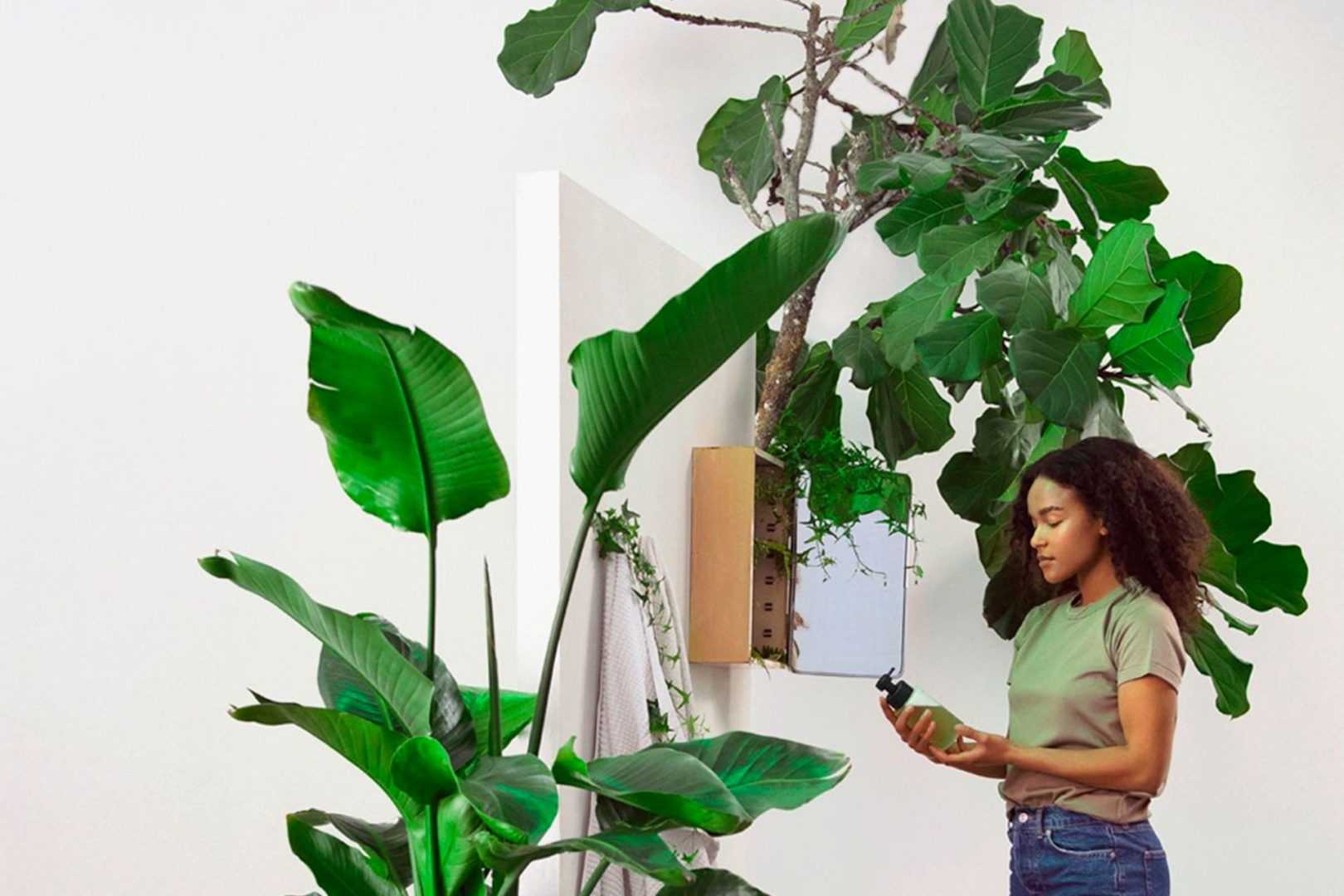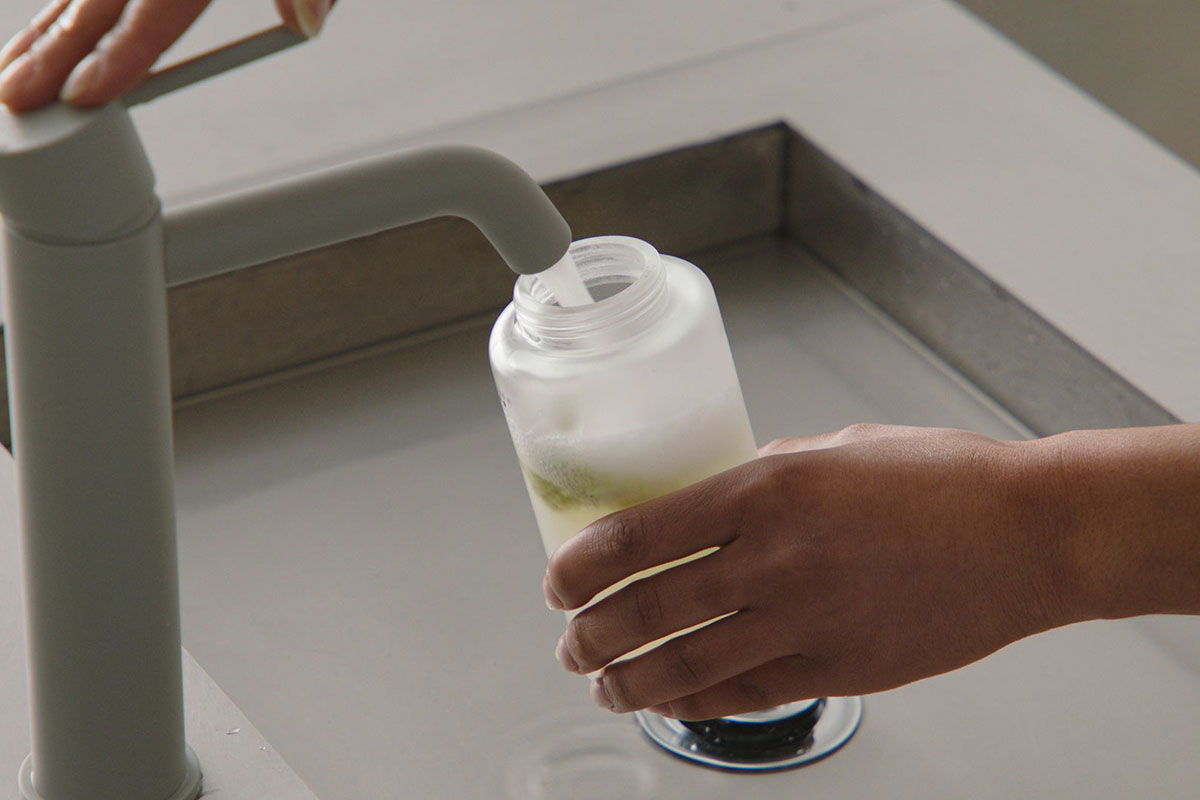«If we have things with the system of refilling or of re-use, then throwing something away or recycling doesn’t have to be the first option». In conversation with Forgo cofounder Allon Libermann
Current mindset of businesses regarding durable products
Founded in 2018 by Allon Libermann, it wasn’t until 2020 that Forgo released their first product. A powder to liquid hand soap. The aim is to reduce plastic waste and overall carbon footprint within that industry; as it ecourages people to stop buying and throwing away plastic soap bottles. The powder soap comes in a paper sachet which doesn’t compromise the biodegradation process. They also sell glass bottles where to out the powder and, by adding some water from the tap, it creates the soap. «Every refill equals about five percent fewer emissions than a bottle of soap», Libermann explains. The concept is straightforward yet one term which marries well with sustainability is biodegradability.
Forgo bottles to last as long as possible
This reasoning has shone a light on the train of thought of some existing manufactures. One particular glass bottle producer, which Libermann had approached in the beginning, prided themselves in using renewable energy. The cost was low and it seemed like a great fit. However, the minimum bulk number which had to be ordered was 500,000 units. This was unnecessary for Forgo as their whole mindset was to encourage reusable bottles which didn’t have to be constantly thrown away. «The bottles are designed to last five or ten years, not one month», he says. «They couldn’t understand this concept. For them, the whole industry, in the last fifty years of consumption, has been about making things to throw away at a competitively-low price point. Even though they are using renewable energy, their business model is harmful for the environment because they need to continue to manufacture».
Carbon investments
This links to yet another way into a more sustainable future. It is about changing the business model, not the materials. This is seen from Forgo’s decision of going the opposite route of biodegradability. Instead of opting for a material that would last longer. The pump of the soap dispenser comes from plastic and steel; something Libermann describes as a carbon investment: «Over the years, you amortize the emissions and damages that you’ve done in creating that product in the first place by making it last a long time», he explains.
«Time is a key metric when you talk about sustainability. The longer something is in use, the less of an impact it has because its emissions amortize in comparison to something that is brand new all the time». The only way in which this can work, however, is by pairing it up with another sustainable methodology. In this case, it is being able to refill the bottles in an environmentally conscious way. «Our bottle is a big investment», Libermann admits. «You buy it once, after you use our soap for about a year, by buying our refills which have a lower carbon emission footprint than a bottle of soap, then you break even on the emission of our bottle. After that, every other refill you get has eighty-five percent less emissions than a new bottle of soap».
The difficulties surrounding the ingredients of the soap
Regarding the ingredients used to create the powder soap, Libermann affirms there is much left which can be done. It is comprised of six ingredients plus the added fragrance and color. One of these ingredients is the surfactant, responsible for creating the foam and cleaning ability of the soap. These are made with sulfate and most of them are synthetic or made with either coconut or palm oil. «Right now, most of our surfactants and ingredients are still based on palm oil and coconut. In the future, we see that we can create our own ingredients from something as basic as corn, enzymes or algae», he explains.
As this product is within the personal care industry, and regarding hygiene, there are several regulations which limit the extent in which Forgo can work without doing harm to the environment. One requirement is the need for at least one percent being preservative which are «by nature, designed to kill microbes. Everything can be harmful in high enough quantities. Everything is about balance. We use ingredients which are quite low in toxicity».
The fragrances used: sourced from waste streams
These include leftover tree tops from the lumber industry in Canada as well as citrus leftovers from juicing plants — peels and pulp. «We didn’t want to use anything synthetic in our fragrances which has created its own set of challenges», Libermann explains. «People are familiar to these smells that stick to your skin and last a long time. Those smells are all synthetic for the most part».
Although Forgo is working to minimize harm done to the environment through their choices of ingredients, the lack of transparency and communication from where these resources come from does create an issue. There is little control over where these ingredients are actually sourced. As larger companies receive these resources in bulk from auctions, «there is little oversight over the labor conditions, how the farm is managed, deforestation circumstances and whether or not there are pesticides», he points out. This is why localizing is key. Although Forgo is based in Stockholm, they produce their product in Canada. However, they are in the process of moving their factory to France to «localize within Europe as much as possible».
The priorities of big companies
We all know that big brands prefer to prioritize volume over sustainable production. This is where marketing comes into play. «Often brands are working on sustainability projects more for marketing purposes», he explains. This goes hand in hand with the discussion mentioned above about business models. Although some may use sustainable, non-toxic and recycled materials with a low carbon footprint, the sheer mass which they produce is enough to disregard them as an environmentally conscious business. Libermann explains this concept with an example.
«One of my personal favorites would be to be able to do this in the shoe industry. I know that powder refill doesn’t make sense for a shoe. But, the same thinking and common sense that we applied to Forgo, we can apply it to different industries. Despite all the money that is going into the shoe industry, no one is asking the simple questions. What actually creates the least environmental harm? What has fewer emissions? The first question that most sneaker companies are thinking about is: how can I sell you, a customer, sneakers at least twice a year? Only after that, they ask themselves, how can we make those sneakers have less impact on the environment? But that is just a marketing trick for you to feel more comfortable about buying sneakers two times a year».
The limitations of recyclability
The consumption habits of society is a major factor to all of this. Current business models are built to accommodate the volume of wants. «Over the past fifteen years, as we’ve become more aware, we’ve produced over half the world’s plastic waste compared to the last sixty years before that», Libermann says. «Even though we are more conscious towards the environment, we are actually consuming more personal care, consuming more beauty care, consuming more than we ever have before in history».
What convinces us to continue buying goods are the marketing tricks which companies indulge in to make us feel better about continuously buying product after product. One example is the concept of recyclability. Although you may recycle plastic, and then that plastic gets down cycled into another product, there are only so many more down cycles it can go through before it gets discarded and incinerated in landfills. «Do we always need to have things that we can throw away?», he questions. «If we have things with the system of refilling or of re-use, then throwing something away or recycling doesn’t have to be the first option».
Changing business models is not rocket science
The idea of powder to liquid soap may seem like a simple product concept which contributes to a sustainable future. However, it develops ideas much further than that. Current business models are not in place to directly impact the issue surrounding consumption habits, quite the opposite actually. Of course, transparency, material sourcing and manufacturing processes all play a big part in being more environmentally-friendly.
However, that is not the starting point for most of these companies but rather producing something which consumers will continuously buy. Changing these models may be difficult for major companies but Libermann is adamant that most are just excuses: «It didn’t take a large amount of money. This shows that switching supply chains and making the common-sense decisions of low-waste, low-emissions and low-toxicity is not rocket science. It isn’t that there is a lack of innovation or know-how, it’s just that companies are so set in their ways of making money from bad things that it’s hard for a big company to change their ways».
Forgo
Stockholm-based brand which produces powder to liquid soap. They are working on extending this way of doing to more products within the personal care industry. The powder is put into a dispenser bottle, water is added and after shaking it a bit, the soap becomes liquid and ready to use.
The world of marketing has contorted our perspective on sustainability. Brands have taken advantage of the power of marketing by giving their consumers half truths. This is where the issue of greenwashing arises. It is also why other brands understand the need to go one step further in communicating sustainable measures. Forgo is a Stockholm-based brand focused on producing powder to liquid hand wash in plastic-free refills. It is run by Allon Libermann, who is hoping to extend this concept to more products within personal care.




















